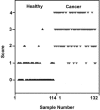Serum protein markers for early detection of ovarian cancer
- PMID: 15890779
- PMCID: PMC1140439
- DOI: 10.1073/pnas.0502178102
Serum protein markers for early detection of ovarian cancer
Abstract
Early diagnosis of epithelial ovarian cancer (EOC) would significantly decrease the morbidity and mortality from this disease but is difficult in the absence of physical symptoms. Here, we report a blood test, based on the simultaneous quantization of four analytes (leptin, prolactin, osteopontin, and insulin-like growth factor-II), that can discriminate between disease-free and EOC patients, including patients diagnosed with stage I and II disease, with high efficiency (95%). Microarray analysis was used initially to determine the levels of 169 proteins in serum from 28 healthy women, 18 women newly diagnosed with EOC, and 40 women with recurrent disease. Evaluation of proteins that showed significant differences in expression between controls and cancer patients by ELISA assays yielded the four analytes. These four proteins then were evaluated in a blind cross-validation study by using an additional 106 healthy females and 100 patients with EOC (24 stage I/II and 76 stage III/IV). Upon sample decoding, the results were analyzed by using three different classification algorithms and a binary code methodology. The four-analyte test was further validated in a blind binary code study by using 40 additional serum samples from normal and EOC cancer patients. No single protein could completely distinguish the cancer group from the healthy controls. However, the combination of the four analytes exhibited the following: sensitivity 95%, positive predictive value (PPV) 95%, specificity 95%, and negative predictive value (NPV) 94%, a considerable improvement on current methodology.
Figures




References
-
- Jemal, A., Murray, T., Ward, E., Samuels, A., Tiwari, R., Ghafoor, A., Feuer, E. L. & Thun, M. J. (2005) CA Cancer J. Clin. 55, 10–30. - PubMed
-
- Schwartz, D. R., Kardia, S. L., Shedden, K. A., Kuick, R., Michailidis, G., Taylor, J. M., Misek, D. E., Wu, R., Zhai, Y., Darrah, D. M., et al. (2002) Cancer Res. 62, 4722–4729. - PubMed
-
- Lu, K. H., Patterson, A. P., Wang. L, Marquez, R. T., Atkinson, E. N., Baggerly, K. A., Ramoth, L. R., Rosen, D. G., Liu, J., Hellstrom, I., et al. (2004) Clin. Cancer Res. 10, 3291–3300. - PubMed
-
- Petricoin, E. F., Ardekani, A. M., Hitt, B. A., Levine, P. J., Fusaro, V. A., Steinberg, S. M., Mills, G. B., Simone, C., Fishman D. A., Kohn, E. C., et al. (2002) Lancet 359, 572–577. - PubMed
-
- McIntosh, M. W., Urban, N. & Karlan, B. (2002) Cancer Epidemiol. Biomarkers Prev. 11, 159–166. - PubMed
Publication types
MeSH terms
Substances
LinkOut - more resources
Full Text Sources
Other Literature Sources
Medical
Research Materials
Miscellaneous

